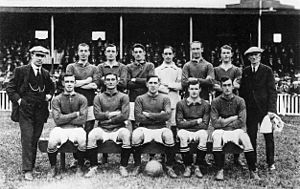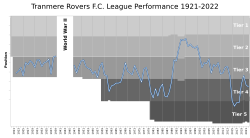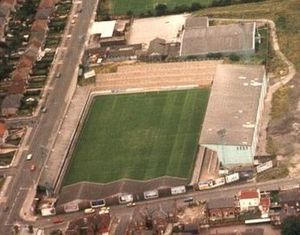Tranmere Rovers F.C. facts for kids
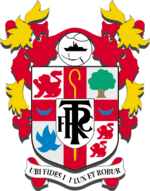 |
||||
| Full name | Tranmere Rovers Football Club | |||
|---|---|---|---|---|
| Nickname(s) | The Rovers | |||
| Short name | Rovers, Super White Army | |||
| Founded | 1884 (as Belmont FC) | |||
| Ground | Prenton Park | |||
| Capacity | 16,567 | |||
| Owner | Mark & Nicola Palios | |||
| Chairman | Mark Palios | |||
| Manager | Andy Crosby | |||
| League | League One | |||
| 2018–19 | League Two, 6th of 24 (promoted via play-offs) | |||
|
||||
Tranmere Rovers Football Club is a professional football team from Birkenhead, Merseyside, England. They are currently playing in League One, which is the fourth level of English football.
The club started in 1884 as Belmont Football Club and changed its name to Tranmere Rovers in 1885. Their main uniform is all white with blue details, a style they have used since 1962. Tranmere Rovers moved to their current stadium, Prenton Park, in 1912. The stadium was updated in 1995 and can now hold 16,567 fans.
Tranmere played in local leagues before joining the Football League in 1921. They won their first championship in 1938 but were relegated the next year. The 1990s were a very successful time for the club. They almost reached the Premier League and made it to the 2000 Football League Cup final. After some ups and downs, including leaving the Football League for three seasons, they returned in 2018 and earned back-to-back promotions in 2018 and 2019.
Contents
History of Tranmere Rovers
How the Club Started
|
|
| 1889–1904 kit |
Tranmere Rovers began in 1884 when two cricket clubs, Lyndhurst Wanderers and Belmont, combined their football teams. On November 15, 1884, they won their first game 4–0. This was a friendly match because official leagues did not exist yet. Before their second season, on September 16, 1885, Belmont F.C. changed its name to Tranmere Rovers.
The team first played at Steeles Field in Birkenhead. In 1887, they moved to Ravenshaws Field, which was renamed Prenton Park in 1895. However, the team moved to the current Prenton Park stadium in 1912. Tranmere first wore blue shirts, white shorts, and blue socks. In 1889, they tried orange and maroon shirts but went back to their original blue and white in 1904.
Tranmere joined stronger leagues over the years, winning the Combination championship in 1908 and the Lancashire Combination Championship in 1914. During World War I, Rovers continued to play, even though some players were criticized for not joining the military.
Years Between the Wars
|
|
| 1921–37 kit |
In 1921, Tranmere was invited to join the new Football League Third Division North. On August 27, 1921, they won their first Football League match 4–1 against Crewe Alexandra. Bert Cooke was their manager for 23 years, which is a club record.
In 1924, a young player named Dixie Dean made his debut at just 16 years old. He scored 27 goals in 30 games for Rovers before moving to Everton. Another talented player, Pongo Waring, scored six goals in an 11–1 win against Durham City before moving to Aston Villa.
In 1934, a record 61,036 fans watched Tranmere play Liverpool in an FA Cup game. A year later, Bunny Bell scored 40 goals in the 1935–36 season, including nine goals in a huge 13–4 win over Oldham Athletic. The total of 17 goals in that game is still a league record.
Tranmere also played in the Welsh Cup, winning it in 1935 by beating local rivals Chester 1–0. In 1938, Rovers won their first Football League championship in Division Three North, moving up to Division Two. However, they were relegated the very next season.
The "Superwhites" Era
|
|
| 1962–63 kit |
After World War II, Tranmere rejoined the Football League. In 1961, their captain Harold Bell left the club. He had played 459 games in a row, a British record! After he left, Rovers were relegated to Division Four.
The club hired Dave Russell as manager. He changed the team's kit from blue to all white to make them stand out from local rivals Everton. This is why they are now called the "Superwhites." Russell also started a successful youth program. He led Rovers back to Division Three in 1967. In 1972, Ron Yeats became player-manager and brought in former Liverpool players. In 1973, Tranmere famously beat First Division team Arsenal 1–0 in a League Cup game.
The 1980s were tough for the club, with money problems and low attendance. In 1987, the club faced serious financial difficulties.
The John King Era
Local businessman Peter Johnson took over the club, which was a big turning point. Manager John King led the team from the bottom of Division Four to almost reaching England's top league. In 1988, Tranmere played at Wembley Stadium for the first time.
The next season, King helped Tranmere get promoted from Division Four. In 1990, they won their first major trophy, the Associate Members' Cup, at Wembley. Striker Ian Muir was a key player, scoring 180 goals for the club.
|
|
| 1999–2000 kit |
In the 1990–91 season, Tranmere was promoted to Division Two. They played at Wembley four times in just over a year! In 1991, former Liverpool player John Aldridge joined Tranmere. He scored 170 goals and was the first Tranmere player to score at a FIFA World Cup. With players like Aldridge and Pat Nevin, Tranmere reached the play-off semi-finals three times in a row, nearly getting promoted to the Premier League.
In 1995, the updated Prenton Park stadium opened. In 1996, John Aldridge became player-manager.
The 2000s and Beyond
In the 1999–2000 season, Tranmere had an amazing cup run. They beat Premier League teams like West Ham United and Sunderland. They reached the 2000 Football League Cup final against Leicester City, their first major final. They lost 2–1, but it was a memorable game at the original Wembley Stadium.

|
|
| 2011–2012 kit |
Despite their cup success, Rovers struggled in the league and were relegated in 2001. They spent 13 seasons in the third tier. In 2014, manager Ronnie Moore was sacked for breaking rules about betting. Tranmere was relegated to League Two.
On August 11, 2014, former player and Football Association chief executive Mark Palios and his wife Nicola took over the club. After a tough season, Tranmere was relegated from the Football League in 2015, ending their 94-year stay.
Non-League Years
Tranmere spent three seasons in the National League. In the 2016–17 season, they finished second and reached the play-offs, but lost in the final at Wembley.
The 2017–18 season started slowly, but Tranmere improved greatly. They finished second again and reached the play-offs. On May 12, 2018, they won the National League play-off final 2–1 against Boreham Wood at Wembley. This was their first trophy in 27 years, and it meant they were promoted back to the Football League!
Return to the Football League
Under chairman Mark Palios and manager Micky Mellon, Tranmere played in League Two in the 2018–19 season. They finished 6th and reached the play-offs again. On May 25, 2019, Tranmere earned back-to-back promotions by beating Newport County 1–0 at Wembley, securing their spot in League One.
In March 2020, the season was stopped early due to the COVID-19 pandemic. Clubs voted to decide promotion and relegation based on points per game. This meant Tranmere was moved down to League Two, which the club chairman felt was unfair.
Since then, Tranmere has had several managers. Micky Mellon returned for a second time in May 2021 but left in March 2023. Nigel Adkins became manager in November 2023 but left in February 2025. Andy Crosby is now the manager until the end of the season.
Team Colors and Crest
Tranmere Rovers' first colors were blue shirts and white shorts. In 1889, they tried orange and maroon shirts to "dazzle" opponents, but went back to blue and white in 1904. In 1962, manager Dave Russell introduced an all-white uniform with blue trim. He wanted Tranmere to have its own identity, different from Liverpool's red and Everton's blue. Since then, white has been their main color, earning them the nickname "Superwhites."
Tranmere first put a badge on their shirt in 1962. It was the coat of arms of Birkenhead, with the motto "Where there is faith there is light and strength." Over the years, the crest changed several times. In 1987, a more detailed crest was introduced, including a football and the TRFC logo. A simpler badge was adopted in 1997 and updated in 2009 for the club's 125th anniversary. For the 2021–22 season, Tranmere went back to their badge used before 1997.
Prenton Park Stadium
Rovers first played at Steeles Field in Birkenhead. In 1887, they moved to a new site, which was eventually named "Prenton Park" in 1895. However, they had to move again for housing and a school. The current Prenton Park opened on March 9, 1912. It had stands and open terraces.
Major changes to the stadium happened in 1994 and 1995 because of new safety rules. These rules said that all stadiums in the top two divisions of English football should have only seats, no standing areas. So, three sides of the ground were rebuilt with new all-seater stands. The stadium's capacity increased to 16,567 seats. The new stadium officially opened on March 11, 1995.
About 8,000 fans watched the first game at the current stadium in 1912. The largest crowd ever at Prenton Park was 24,424 for an FA Cup match in 1972. In recent years, average attendance has been around 6,000 to 8,000 fans.
Supporters and Rivalries
Tranmere Rovers had an average home attendance of 6,398 during the 2024–25 season. This makes them the 10th best-supported club in League Two. The club has several fan groups, like the Tranmere Rovers Supporters Trust. In 2010, the trust raised money to help the club sign a player.
Even though Everton and Liverpool are geographically close, Tranmere rarely plays them because they are usually in different leagues. Tranmere has traditional rivalries with nearby teams like Wrexham and Chester. A survey in 2019 showed that Tranmere fans also see Bolton Wanderers and Oldham Athletic as big rivals.
Here are the teams Tranmere has played most often in the Football League:
| Opponents | P | W | D | L | W% |
|---|---|---|---|---|---|
| Crewe Alexandra | 120 | 53 | 26 | 41 | 44.2 |
| Hartlepool United | 118 | 52 | 28 | 38 | 44.1 |
| Rochdale | 113 | 54 | 23 | 36 | 47.8 |
| Stockport County | 108 | 40 | 31 | 37 | 37.0 |
| Halifax Town | 104 | 42 | 28 | 34 | 40.4 |
| Wrexham | 102 | 38 | 25 | 39 | 37.3 |
| Chesterfield | 94 | 31 | 19 | 44 | 33.0 |
| Bradford City | 86 | 36 | 20 | 30 | 41.9 |
| Darlington | 82 | 38 | 13 | 31 | 46.3 |
| Southport | 80 | 38 | 22 | 20 | 47.5 |
Tranmere Rovers Ladies Team
Tranmere Rovers Ladies Football Club started in 1990. They are connected to the men's team and play their home games at Ellesmere Port Sports Village. From 1996 to 2004, they played in the top women's football league in England. As of 2025, they play in the North West Regional League, Premier Division.
Players of Tranmere Rovers
Current First-Team Squad
|
|
Famous Former Players
In 2010, for the club's 125th anniversary, Tranmere started a hall of fame. The first players and managers honored were Ian Muir, John Aldridge, John King, Ray Mathias, Steve Mungall, John Morrissey, and Pat Nevin. Harold Bell holds a record for playing the most consecutive league games for a British team, with 401 matches in a row.
Club Officials
Coaching Staff
| Position | Name |
|---|---|
| Manager | Andy Crosby |
| Assistant Manager | Andy Parkinson |
| Goalkeeping Coach | Joe Murphy |
| Player Development Manager | Alan Morgan |
| Physiotherapist | Karly Bland |
| Sports Scientist | Mark Cowan |
| Chief Scout | Ollie Knight |
| Performance Analyst | Kevin Mulligan |
Club Managers
Since 1912, Tranmere Rovers has had 40 different managers. Bert Cooke was the first, managing for 23 years, the longest time for any manager at the club. Dave Russell, who took over in 1961, introduced the team's all-white uniform.
The most successful period was led by John King, who returned to the club in 1987. He led them to win the League Trophy and helped them climb from the lowest division to almost reach the Premier League three times. After King, John Aldridge became manager, and the team reached the 2000 Football League Cup final.
More recently, Micky Mellon led the team to two play-off final victories in 2018 and 2019, bringing them back to League One. After Mellon left in 2020, the club had several managers, including Mike Jackson and Keith Hill. Mellon returned in 2021 for a second time. As of February 2025, Andy Crosby is the current manager.
Here are some of the full-time managers the club has had:
| Manager | From | To | P | W | D | L | W% | Reference |
|---|---|---|---|---|---|---|---|---|
| Bert Cooke | 1 August 1912 | 30 April 1935 | 607 | 258 | 123 | 226 | 42.5 | |
| Jack Carr | 1 May 1935 | 1 November 1936 | 60 | 27 | 17 | 16 | 45.0 | |
| Jim Knowles | 1 November 1936 | 1 January 1939 | 98 | 38 | 16 | 44 | 38.8 | |
| Bill Ridding | 1 January 1939 | 31 May 1945 | 20 | 3 | 3 | 14 | 15.0 | |
| Ernest Blackburn | 1 September 1946 | 1 May 1955 | 421 | 172 | 83 | 166 | 40.9 | |
| Noel Kelly | 1 July 1955 | 1 October 1957 | 107 | 26 | 25 | 56 | 24.3 | |
| Peter Farrell | 1 October 1957 | 31 December 1960 | 164 | 63 | 34 | 67 | 38.4 | |
| Walter Galbraith | 1 January 1961 | 1 December 1961 | 43 | 20 | 3 | 20 | 46.5 | |
| Dave Russell | 1 December 1961 | 1 December 1969 | 402 | 175 | 88 | 139 | 43.5 | |
| Jackie Wright | 1 December 1969 | 1 April 1972 | 132 | 35 | 57 | 40 | 26.5
|
|
| Ron Yeats | 8 April 1972 | 4 April 1975 | 156 | 49 | 44 | 63 | 31.4 | |
| John King | 13 April 1975 | 30 September 1980 | 269 | 86 | 79 | 104 | 32.0 | |
| Bryan Hamilton | 1 October 1980 | 7 February 1985 | 232 | 75 | 64 | 93 | 32.3 | |
| Frank Worthington | 9 July 1985 | 11 February 1987 | 83 | 24 | 23 | 36 | 28.9 | |
| John King | 13 April 1987 | 12 April 1996 | 488 | 211 | 129 | 148 | 43.2 | |
| John Aldridge | 12 April 1996 | 17 March 2001 | 269 | 93 | 78 | 98 | 34.6 | |
| Dave Watson | 20 May 2001 | 1 August 2002 | 55 | 22 | 15 | 18 | 40.0 | |
| Ray Mathias | 1 August 2002 | 29 September 2003 | 66 | 29 | 18 | 19 | 43.9 | |
| Brian Little | 12 October 2003 | 9 June 2006 | 147 | 61 | 43 | 43 | 41.5 | |
| Ronnie Moore | 9 June 2006 | 5 June 2009 | 171 | 71 | 42 | 58 | 41.5 | |
| John Barnes | 14 June 2009 | 9 October 2009 | 14 | 3 | 1 | 10 | 21.4 | |
| Les Parry | 9 October 2009 | 4 March 2012 | 131 | 40 | 34 | 57 | 30.5 | |
| Ronnie Moore | 4 March 2012 | 9 April 2014 | 111 | 41 | 25 | 45 | 36.9 | |
| Rob Edwards | 27 May 2014 | 13 October 2014 | 14 | 2 | 4 | 8 | 14.3 | |
| Micky Adams | 16 October 2014 | 19 April 2015 | 38 | 10 | 11 | 17 | 26.3 | |
| Gary Brabin | 5 May 2015 | 18 September 2016 | 60 | 28 | 15 | 17 | 46.7 | |
| Micky Mellon | 7 October 2016 | 6 July 2020 | 198 | 91 | 45 | 62 | 46.0 | |
| Mike Jackson | 18 July 2020 | 31 October 2020 | 13 | 3 | 5 | 5 | 23.1 | |
| Keith Hill | 21 November 2020 | 11 May 2021 | 40 | 20 | 10 | 10 | 50.0 | |
| Micky Mellon | 31 May 2021 | 19 March 2023 | 97 | 39 | 25 | 33 | 40.2 | |
| Ian Dawes | 20 March 2023 | 10 September 2023 | 19 | 3 | 5 | 11 | 15.8 | |
| Nigel Adkins | 2 November 2023 | 26 February 2025 | 72 | 23 | 16 | 33 | 31.9 |
Club Achievements
Here are some of the main achievements of Tranmere Rovers:
League Titles
- Third Division North / Third Division (level 3)
- Champions: 1937–38
- Play-off winners: 1991
- Fourth Division / League Two (level 4)
- Runners-up: 1988–89
- Promoted: 1966–67, 1975–76
- Play-off winners: 2019
- National League (level 5)
- Play-off winners: 2018
- The Combination
- Champions: 1907–08
- Lancashire Combination
- Champions: 1913–14
Cup Competitions
- Football League Cup
- Runners-up: 1999–2000
- Associate Members' Cup / Football League Trophy / EFL Trophy
- Winners: 1989–90
- Runners-up: 1990–91, 2020–21
- Welsh Cup
- Winners: 1934–35
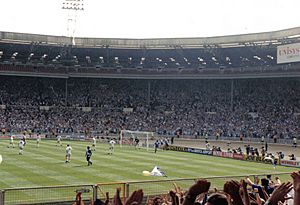
Club Records
- Highest league finish: 4th in First Division (level 2), 1992–93
- Best FA Cup performance: Quarter-finals, 1999–2000, 2000–01, 2003–04
- Best League Cup performance: Runners-up, 1999–2000
- Best League Trophy performance: Winners, 1989–90
- Best FA Trophy performance: Semi-finals, 2016–17
- Record win:
- 13–4, against Oldham Athletic, December 26, 1935 (17 goals in one game is a league record)
- 9–0 against Solihull Moors, April 8, 2017
- Record defeat:
- 1–9 against Tottenham Hotspur, FA Cup 3rd round replay, January 14, 1953
- Highest home attendance: 24,424, against Stoke City, February 5, 1972, FA Cup
- Most goals (total): Ian Muir, 180
- Most goals in a season: Bunny Bell (1934–35) and John Aldridge (1991–92)
- Most appearances: Ray Mathias, 637
See also
 In Spanish: Tranmere Rovers Football Club para niños
In Spanish: Tranmere Rovers Football Club para niños


